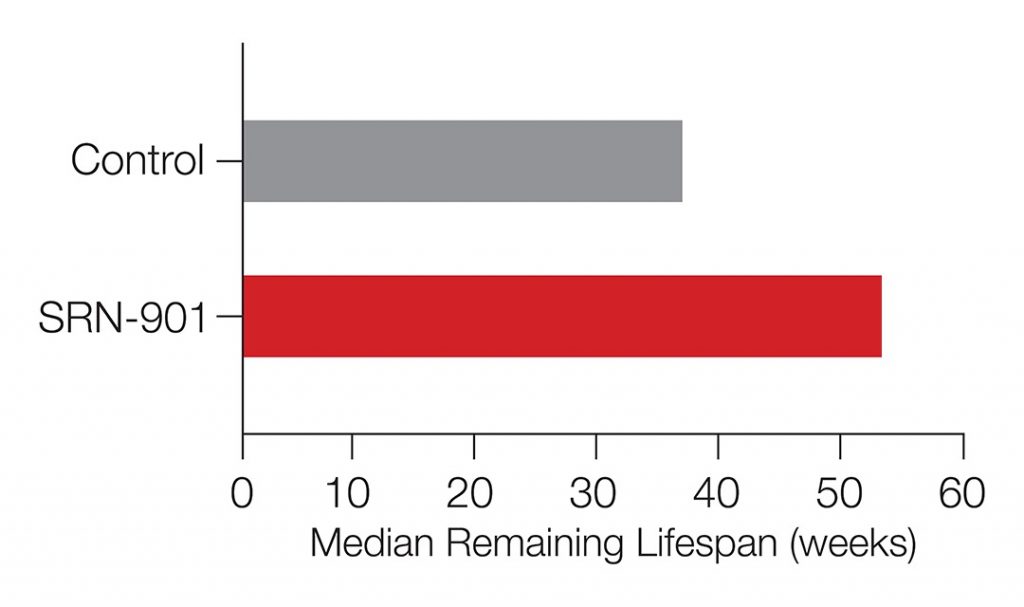Key Points:
- SRN-901 extends the remaining lifespan of middle-aged mice by 34%.
- Pro-longevity genes and biomarkers were significantly increased while anti-longevity genes and biomarkers were significantly decreased by SRN-901 in aged mice.
- SRN-901 significantly improves the healthspan of aged mice by mitigating cognitive deficits, frailty, and tumor incidence.
In a May 7, 2024 press release, Seragon Biosciences announced the results of SRN-901’s impact on aging in mice. They found that SRN-901 “achieved one of the largest extensions of lifespan healthspan to date.” In an interview, David Brown Ph.D., Senior Scientist at Seragon Biosciences, revealed,
“Our novel anti-aging drug SRN-901 contains many of the most potent aging intervention technologies, including those involved in mTOR inhibition, autophagy and mitophagy activation, NAD+ enhancement, and senolytic stimulation. We orally administered the drug to middle-aged mice [equivalent to a human in their 50s] and were delighted to see that, compared to control mice, our intervention increased their remaining lifespan by one-third.”

Dr. Brown pointed out that this is the single greatest extension of lifespan to date from an oral drug, beating even rapamycin under the same conditions. He also explained that they began treating the mice with SRN-901 at an age equivalent to our 50’s. Still, the mice (over 300 of them) were monitored across their entire lifespan, from 2021 to 2024. Furthermore, Brown said,
“With a considerable sample size, we examined our mouse cohort across several levels of analysis, encompassing RNA sequencing, physiological function, metabolism, transcriptomics, and proteomics. All brought together with machine learning-assisted bioinformatics.” He continued, “In analyzing longevity-associated gene expression levels, we found that aged mice treated with SRN-901 exhibited expression levels strikingly similar to that of young mice. Interestingly, when compared to the popular NAD+ precursor NMN, SRN-901 had significantly more robust effects.”

Dr. Brown also told us of some notable longevity genes, such as Sirt6, Parp1, and Sod2, increased by over 70% on average. In contrast, anti-longevity genes, such as Igf1r, Ccl4, and Il6, were down by 40% on average. Moreover, when looking at specific pro-longevity pathways, the researchers found significant activation of the DNA repair, signal transduction, immune function, and programmed cell death pathways in response to SRN-901 treatment.
Reflecting the positive changes in gene activation observed in SRN-901-treated mice, Brown divulged,
“Our assessment of tissue metabolic markers showed a significant increase in gamma-glutamyl glutamine, and glutathione, a powerful native antioxidant that counteracts oxidative stress, which is known to contribute to DNA damage and cellular aging. We also saw a significant reduction in blood glucose and uric acid levels, both indicators of poor metabolic health.”
This means that SRN-901 increased pro-longevity metabolic biomarkers while reducing anti-longevity metabolic biomarkers, suggesting that SRN-901 improves metabolism.
Improving Healthspan for Better Living
Lifespan extension may only be worthwhile if accompanied by an increase in healthspan — the number of years lived in good health. However, with recent gains in worldwide life expectancy, there has been an uptick in chronic age-related diseases (e.g. Alzheimer’s and cancer), limiting people’s healthspan. Thus, finding ways to increase healthspan has become of paramount importance.
“In what we believe to be one of the most comprehensive systematic assessments of observable age-associated phenotypes, in terms of breadth, we found SRN-901 to improve several key indicators of healthspan,” said Dr. Brown.
Brown specified that SRN-901 enhanced the cognition of aged mice, which could deter dementia and Alzheimer’s. Additionally, SRN-901 improved the physical performance of aged mice, as assessed by treadmill running. Namely, while aged mice ran 20% the distance of young mice, SRN-901-treated aged mice ran over 50% the distance of young mice. Essentially, SRN-901 more than doubled the endurance of aged mice.
Furthermore, according to the press release, SRN-901 treatment counteracted frailty — a body-wide measure of impairments, including muscle loss and weakness. And if that wasn’t enough, SRN-901 reduced the occurrence of tumors, suggesting the mitigation of cancer.
A Large-Scale Global Effort
Emphasizing the work, expertise, and resources needed to discover the full range of SRN-901’s capabilities in mice, Dr. Brown said,
“An extensive international network of world-class academic institutions and industry leaders collaborated with Seragon to complete this large-scale, broad but in-depth study. The project involved over ten research groups in five major academic institutions, three leading CROs [contract research organizations], and over twenty technology partners.”
When asked when the data will be published and what the future looks like for SRN-901, Brown responded, “Detailed results for SRN-901 will be published once the supplementary analysis is completed in the coming months. Looking forward, Seragon is confident in moving onto the next phase.”
Meanwhile, we learned that Seragon has licensed a number of patents from Harvard University, Mayo Clinic and Scripps Research. Additionally, Seragon’s RESTORIN series of aging intervention nutraceuticals will share many technologies with SRN-901. Thus, until SRN-901 is released, RESTORIN may be the next best option.